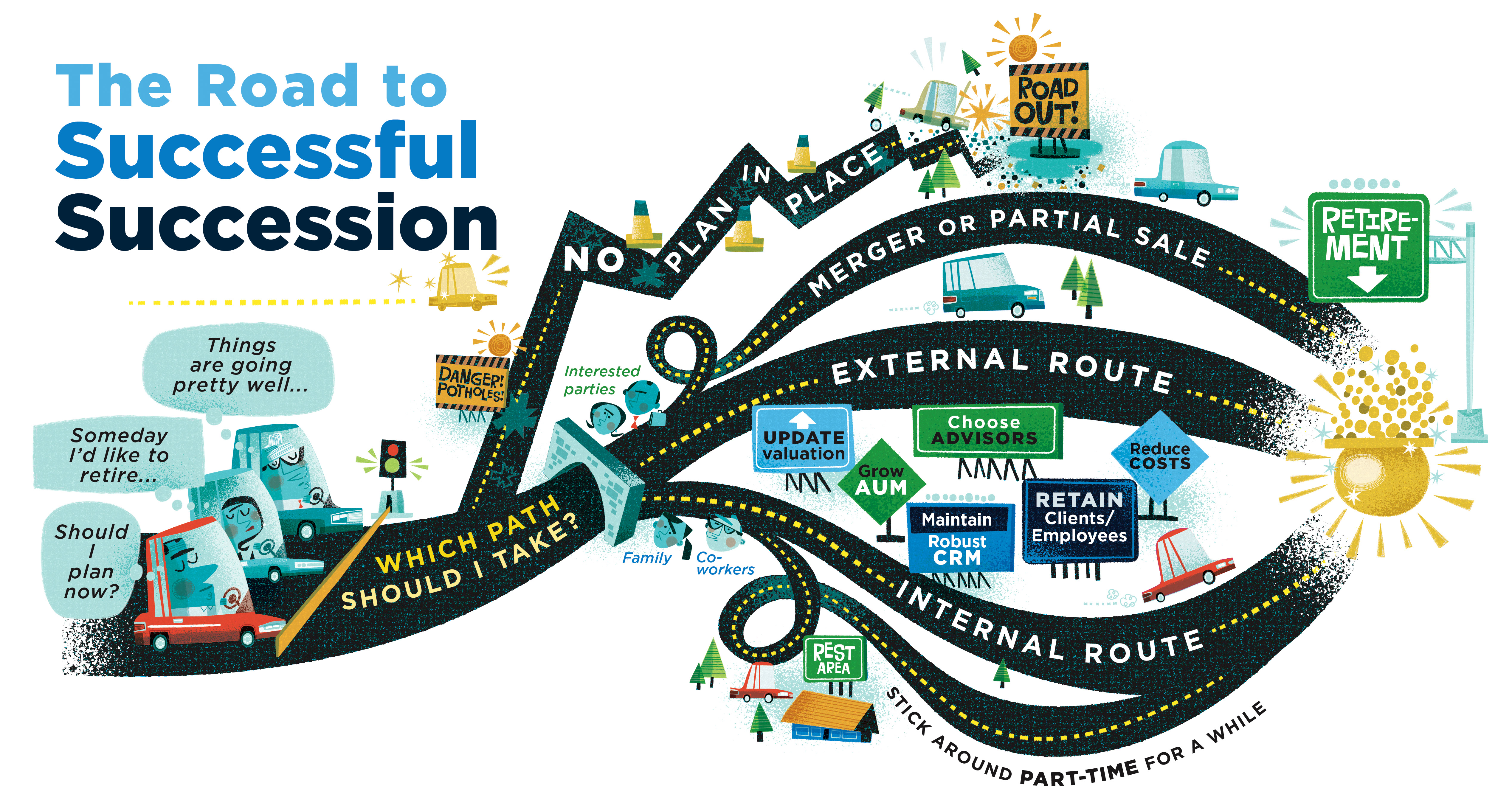If you’re a producer running your own practice, you need to plan for your own succession. It’s crucial to get an early start—ideally years before you intend to retire—and take the right steps to get the result you want.
The state of succession planning is dire…
A producer’s most important functions, arguably, are to create a financial/investment plan for clients to meet their retirement goals and to advise them along the way. While producers are typically very good at educating clients on how to achieve their goals, they often tend to miss the mark when it comes to planning for their own succession.
Several results of a 2018 survey conducted by the Financial Planning Association and Janus Henderson Investors—still considered the leading study of its kind—underscore the dire state of succession planning for producers:
- Just 41% of producer respondents said they had some form of a plan to eventually transition their practice, and only 27% had a formal, documented plan in place.
- Only 52% of producer respondents felt at least somewhat prepared to transition their business to someone else.
- Nearly all producer respondents—95%—said that the absence of a succession plan was a risk.
Another study, by J.D. Power, found that around 20% of producers are at least 65 years old and producers’ average age is around 55.
The inescapable conclusion of these numbers is that many producers face the double whammy of being close to retirement without having a succession plan in place.
…Even as demand for practices is high
The lack of succession planning comes at a time when demand for wealth management practices has never been higher. According to DeVoe & Company, there were 242 mergers or acquisitions of registered investment advisers (RIAs) in 2021. Not only was this the highest such total on record and the eighth consecutive annual high, but it also represented a 52% gain versus 2020 and a 169% gain over the preceding five years.
The top categories of practice acquirors in 2021 were consolidator firms (53% of deals), RIA firms (25%), and an “other” grouping (20%) that included private equity, tax and accounting firms, and a diversified financial company. The involvement of private equity was particularly significant, as DeVoe calculated that PE funded 58% of all deals and backed eight of the year’s 10 most active acquirors.
So there are plenty of potential buyers out there looking for producer practices—but buyers see practices without solid succession plans as much less attractive. Put bluntly: If you want to sell your practice, you must have a plan in place.
How to transition your practice: The internal approach
There are two fundamental ways to transition your practice. The first is to sell it to an internal buyer such as your current firm (if you aren’t independent), a producer already on your team, or a family member.
These are the pros and cons of taking the internal approach:
Pros
- The process is easy for clients, as their accounts don’t have to be transferred and their records stay where they are.
- Clients probably would already be familiar with your successor if she/he is a family member or another producer on your team.
- Some clients prefer to work with a family-owned business.
- The buyer’s scrutiny of expenses and business practices tends to be less intense than with an external buyer.
- Some firms have well-developed programs to help match selling producers with potential buying producers, as well as to finance and execute the deal.
Cons
- According to Scott Breault, a senior transition consultant at Elite Consulting Partners, your sale price likely would be much lower than what an external buyer would pay. Breault additionally points out that a lower sale price could be problematic for your family and your estate.
- If the buyer is your current firm, clients might not feel the same allegiance that they feel to you after you’ve worked with them for years.
- If the buyer is a junior partner or another member of your team, it could be difficult for her/him to find a lender to provide financing for the deal.
How to transition your practice: The external approach
The second way to transition your practice is to sell it to an external buyer—a private equity firm, a consolidator business, or another producer.
These are the pros and cons of taking the external approach:
Pros
- Your sale price likely would be much higher than what an internal buyer would pay.
- Private equity and consolidators have battle-tested processes in place that can make the transition easier. They’ve done this before.
- Deal financing is readily available.
- If you choose to keep working, you can do so presumably with access to much greater resources.
Cons
- After having been your own boss for years (if not decades), you now must work for someone else.
- There may be cultural shifts in ideology, investment philosophy, practice, and management.
- There is often a lot of scrutiny of the books/records.
- There is often a lot more client “bleed” when the new FP takes over. They’re an unknown vs. an internal team member, a family member, etc.
Other external options: Partial sale or merger
Partial sale. Consider a partial sale of equity or revenue stream if you’re not yet ready to sell but want to get your feet wet and keep your options open. You get the benefit of a capital infusion (which you can use to grow your practice or otherwise make it a more appealing acquisition target) without giving up ownership—and can use the sale as a way to audition potential buyers.
Merger. An additional external opportunity has become increasingly common in the past few years and applies to producers whose practice doesn’t have enough assets under management (AUM) to interest buyers on its own. In this scenario, producers merge their practice with one or several others to create a much larger book of business that would be a desirable acquisition target.
The merger option offers attractive benefits for sellers. The biggest is that it would likely generate a much higher payout for the merging producers than they could generate on their own. In addition, a merger allows the merging producers to share the responsibilities of running the business instead of having to do it all themselves; widens the breadth of products and services available to clients; generates economies of scale for technology systems and administrative costs; and gives the combined practice more clout with vendors.
Sid Miramontes of RIA Miramontes Capital emphasizes that “Merger candidates must understand from the start that the ultimate sale of the combined practices requires a significant time commitment, typically around five years. This includes three years or so to get the business running smoothly and growing, find an acquiror, and execute the sale, and two years for the selling producers to remain with the business to ensure continuity under the new owners.”
Valuation is critical
Valuing your practice is critical: If you intend to sell, you have to know what it’s worth to prospective buyers. And if the number is lower than you anticipated, you can choose to go forward with reduced expectations or wait for the marketplace to agree with your view.
Valuations typically take the form of a blend of multiples placed on a practice’s top line (revenue) and bottom line (cash flow, usually defined as earnings before interest, taxes, depreciation, and amortization, or EBITDA). A blended multiple of 10X, for example, would be the result of equally weighted 10X multiples for revenue and EBITDA.
Multiples rise along with the level of AUM. They’re higher when markets are strong and lower when markets are weak. Blended multiples tend to favor revenue in strong markets—i.e., when investment management fees rise—and EBITDA in weak markets, when buyers place greatest importance on the practice’s ability to generate enough cash flow to service the debt that finances the deal.
While there are many things sellers can do to attract a higher multiple (see below), perhaps the most vital is for their practice’s revenue stream to be recurring—and thus more predictable. Buyers are more confident when they know that the business’s inflows are consistent (e.g., from quarterly asset management fees or insurance-policy trailers), and they’ll pay more accordingly.
Miramontes suggests that producers update their practice valuations roughly every 18 months. “Updating the valuation allows producers not simply to know what their practice is worth and understand the current marketplace,” he says, “but also to get familiar with the process well before it’s time to sell.”
Key steps to position your practice for sale
Experts recommend several steps producers should take to best position their practice for sale.
Essentials
- Define your retirement. The entire process depends on this. You’ll need to think deeply about when you want to retire—which most often is the time of sale—and what you’d like to do when you get there. Knowing this will help you not simply to invest for retirement (as you advise your clients to do), but also to calculate a sale price that will give you enough to ensure a comfortable retirement. Anecdotal evidence suggests that outcomes are most positive for producers who have a clear vision of what their post-sale life should be.
- Create your succession plan ASAP and revisit it frequently. It’s never too soon to have a succession plan. Doing it years ahead of when you expect to retire gives you plenty of time to update and adjust it as conditions change. Too many producers end up doing it too late (such as when markets are down, there are too many clients to effectively service, health issues arise, or the producer is close to retirement age), which can lead to disastrous outcomes in terms of sale price and process.
Creating a plan years ahead of time is especially important if you intend to sell the business to a junior partner or someone else on your team. This gives you an extended period in which to evaluate potential buyers, discover and resolve issues that may arise, transition buyers into leadership roles, and incentivize them to stay with the practice well into the future.
- Have a contingency plan. You need to follow the same advice you give your clients to prepare for unexpected developments—such as death, disability, or loss of livelihood—that can derail even the best succession plans. Set aside ample cash reserves, have sufficient insurance coverage, keep your estate plan up to date, and maintain clear instructions about how to run the practice in the event of different emergencies.
Financial steps
- Grow AUM and maximize recurring revenues. For buyers, the two most important criteria for determining valuations are assets under management and the proportion of revenues that are recurring or residual Breault, who has matched many buyers and sellers over the years, says that “the higher your AUM and level of recurring revenues, the higher the multiples buyers will pay. Many large buyers won’t even consider acquisition targets whose AUM are under $500 million or if their revenues are mainly one-off commissions.”
- Manage the bottom line. Buyers will scrutinize your financial statements for unnecessary or excessive costs that can be reduced to raise profitability. It’s best to identify and eliminate such costs well before you decide to sell, as doing so will make your practice more attractive to potential buyers—and boost your net income in the process. Talk to your CFO or accountant frequently to stay current on how to manage the bottom line.
- Regularly value the practice. Don’t wait until you’re ready to sell to find out what your business is worth. Make it a standard practice to get a valuation at consistent intervals (e.g., every 18 months or so) and start doing it years before you expect to initiate a deal. There are numerous experienced third-party firms that can do this for you.
The benefits of regular valuation are significant. According to Miramontes, “You’ll know what the marketplace will pay for your practice, how to assemble and package your financial documents, and how to negotiate with potential buyers. And the sale process can be very tough, so having several valuations under your belt can help you manage expectations and be a better deal maker when it’s time for the real thing.”
Non-financial steps
- Assemble a team of advisors. You’ll need a team of specialized advisors—accountants, lawyers, bankers, business brokers (aka recruiters)—to maximize the benefits of a sale. Interview many candidates to find the ones best for you. Once they’re on your team, consult them early and often.
- Retain clients and employees. Your practice wouldn’t be worth buying if you didn’t have a nucleus of long-term, sticky clients and seasoned, smoothly functioning operating personnel. It’s vital to retain both groups to give buyers confidence that they’re getting a viable and valuable enterprise. Breault’s recommendation is to “service your clients so well that they wouldn’t think of going anywhere else for financial advice, and give your key employees—especially junior producers, if they’re your buyer—strong incentives such as retention bonuses, pay raises, or special benefits to stay with the practice at least two years after the sale closes.”
- Create consistent, repeatable workflows and maintain a robust CRM. Buyers want to purchase a practice that operates like a well-oiled machine and has detailed, comprehensive records of client relationships—in other words, a business that will keep on humming after your departure. Make this a reality by creating workflows that are consistent and repeatable, and by maintaining a customer relationship management system to ensure that essential client information doesn’t walk out the door when you do.
For the deal
- Find a buyer that aligns with you. You’ve built your practice based on your business goals and philosophies of investing, client service, and operations. It’s crucial that your buyer shares at least some of these so that you, your clients, and your employees will feel comfortable about the way the practice will be run going forward.
- Think about payout options. Producers have differing thoughts about how they’d like to receive the sale proceeds. Maybe you want the full amount paid upfront or, instead, spread out over a defined time period. Perhaps you’d also like to receive a share of revenues or net income. Regardless, be sure to know what your options are and structure the agreement accordingly. Tax considerations should play a major role in this process as well.
Share
Related resources
More on Practice Management
Your Thriving
Practice
A destination to empower financial professionals to build, manage, and grow their practice
Get started with Global Atlantic
Take the next step with a company that can help elevate your business.
Need help?
Find all the contact information to submit and service your business.
















